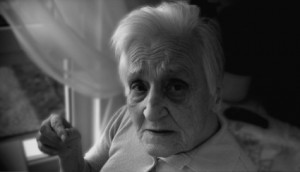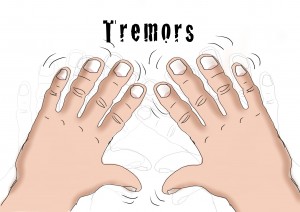Introduction:
Parkinson’s disease is a degenerative disorder of the central nervous system. It happens when nerve cells in the brain don’t produce enough of a brain chemical called dopamine. Early in the course of the disease, the most obvious symptoms are movement-related; these include shaking, rigidity, slowness of movement and difficulty with walking and gait. Later, thinking and behavioral problems may arise, with dementia commonly occurring in the advanced stages of the disease, whereas depression is the most common psychiatric symptom. Other symptoms include sensory, sleep and emotional problems. Parkinson’s disease is more common in older people, with most cases occurring after the age of 50.
It develops gradually, sometimes starting with a barely noticeable tremor in just one hand. But while a tremor may be the most well-known sign of Parkinson’s disease, the disorder also commonly causes stiffness or slowing of movement.
Signs & Symptoms –
Symptoms begin in one limb. Asymmetry persists into later stages. The following are the symptoms observed in a person suffering from Parkinson’s disease.
- Bradykinesia (slowed movements) – Over time, Parkinson’s disease may reduce the patient’s ability to move and slow their movement, making simple tasks difficult and time-consuming. The steps may become shorter while walking or the patient may find it difficult to get out of a chair. Also, they may drag their feet as they try to walk, making it difficult to move.
- Resting tremors – This is primarily of ‘Pill Rolling’ character when it involves the hand. Present when the limb is at complete rest and subsides when the limb moves and takes a new position. The tremor may reemerge – ‘Reemergent Tremor’, within a short time after maintaining new position. Resting tremor diminishes with action. Although it may not be disabling, it is quite embarrassing and associated with aching or fatigue of the affected limb. Resting tremors are usually accentuated by stress like asking the patient to perform mental calculations. They are characteristically present in the upper limbs while walking.
- Rigidity – Muscle stiffness may occur in any part of the body. The stiff muscles can limit the range of motion and cause severe pain. Rigidity is a form of increased muscle tone appreciated best on slow passive movements. It may be characterized as ‘cogwheel’ when a tremor is superimposed or as ‘lead pipe’ when it is not.
- Gait disturbance/postural instability – There may be balance problems or the posture may differ, as a result of Parkinson’s disease. Patients may complain of being unable to stop themselves from going forward or backward. Decreased ability to swing the arms while walking may also be present.
- Micrographia – Handwriting becomes small.
- Reduced eye blink – In Parkinson’s disease, there may be decreased ability to perform unconscious movements, including blinking, smiling or while walking. Lack of facial expression with reduced blinking may result as Parkinsonism interferes with all voluntary activities. As a result, patients with Parkinson’s disease develop the ‘Reptilian Stare’ that is hypomimia or masked facies.
- Soft voice (hypophonia) – There may be speech problems experienced as a result of Parkinson’s disease. Patient may speak softly, quickly, slur or hesitate before talking. Speech may be more monotonous rather than with the usual inflections.
- Dysphagia – Impaired swallowing may result in drooling (sialorrhoea).
- Other Symptoms – In addition to the motor features of parkinsonism, various non-motor features are extremely common which include – anosmia, sensory disturbances (e.g. pain), mood disorders (e.g. depression), sleep disturbances, autonomic disturbances, orthostatic hypotension (lowered blood pressure on standing), gastrointestinal disturbances, urinary urgency and frequency, male erectile dysfunction and cognitive impairment and dementia.
Causes of Parkinson’s disease –
In Parkinson’s disease, certain nerve cells (neurons) in the brain gradually break down or die. Many of the symptoms are due to loss of neurons that produce a chemical messenger in your brain called dopamine. When dopamine levels decrease, it causes abnormal brain activity, leading to signs of Parkinson’s disease.
The cause of Parkinson’s disease is unknown, but several factors appear to play a role, including:
- Environmental Factors – Exposure to pesticides, rural living and drinking well water increase the risk of developing symptoms of Parkinson’s disease. There is a reduced risk with cigarette smoking and caffeine.
- Genetic Factors – Researchers have identified specific genetic mutations that can cause Parkinson’s disease, but these are uncommon except in rare cases with many family members affected by Parkinson’s disease. However, certain gene variations appear to increase the risk of Parkinson’s disease.
Homoeopathic Approach in treating Parkinson’s disease:
The fundamental problem in Parkinson’s disease appears to be genetic. Homoeopathy looks for the underlying causes of Parkinsonism thereby dealing with it at the root level.
Parkinsonism treated in the conventional method is usually with the help of medical supplements which mimic the action of dopamine. There is no permanent cure for Parkinson’s disease in the modern system of medicine. Counseling with physiotherapy and exercise is also advised during the treatment of Parkinsonism. Homoeopathy helps in targeting the root cause of the problem and thereby deals with the causes of Parkinsonism from within. The main aim and objective of Homoeopathy has always been to treat a person individually and relieve the patient of their symptoms from within.
Homoeopathy helps in treating the weakness of the body, tremors, rigidity, numbness, unsteady gait and other such problems experienced by a person suffering from Parkinson’s disease. Homoeopathy thereby helps in improving the core immune status of the patient. Thus by means of which, the affected adult can continue his daily routine and lifestyle without being dependent on anyone.
The homoeopathic treatment for Parkinson’s disease is based on an extensive case study of the patient with regards to his/her characteristic symptoms, genetic predisposition, and their mental state. The total time taken for the treatment differs from person to person depending on the duration, intensity and frequency of the suffering, maintaining causes, susceptibility and general health of the patient.
The goal of homoeopathic treatment for Parkinson’s disease is to identify the main cause for the occurrence of symptoms. Homoeopathy then uses the body’s own immunity and will power to overcome the motor difficulties faced by the patient.
Homoeopathy chosen during the early stages helps prevent rapid progression of the disease and thereby prevents complications. Homoeopathy helps in improving the lifestyle of the patient suffering from Parkinson’s disease by mobilizing him and letting him continue his daily activities without taking anybody’s help.
Hence homoeopathic treatment along with physiotherapy, music therapies and exercise can help in improving the lifestyle of an adult diagnosed with Parkinson’s disease and thus let them lead a hassle free independent life.
It is therefore advisable to choose Homoeopathy for treating your old aged relative of Parkinson’s disease, because it helps to deal with the motor disabilities faced by the Parkinsonism affected adult thereby allowing him to live a better free life.
How Dr. Neha Seth can help you with your Parkinson’s disease?
Dr. Neha Seth believes in giving the patient immediate relief with a shorter period of treatment. The prime line of treatment is to consider every disease to be a result of an allergy. The patient is first asked to get her Serum IgE levels done. The Serum IgE levels are expected to be high in every patient with symptoms. To know the allergen that is causing the disease, an allergy test is done. There are two types of allergy tests that are done – a blood test and a skin test. Usually the skin allergy test is asked for; reason being it costs 1/10th the cost of the blood test. With the help of the allergy test, the allergen is identified and treated accordingly. The patient is immediately asked to stop consuming that food item which is the primary allergen. If the allergen isn’t a food item and it is rather something like dust, pollen or chemicals etc, then the patient is expected to minimize the exposure as much as possible and keep away from the disease causing allergen. Since the maintaining and the causative factors are now known, homoeopathy works wonderfully once these causes are removed. The relatives of the Parkinson affected adult will therefore experience a reduction in the intensity and frequency of the motor symptoms.
With effective homeopathic treatment, most adults can hopefully continue living their normal life without any hindrance and thus stay at home without having the need to go to a special old age home. Hence, Dr. Neha Seth and Homoeopathy can help you in dealing with your Parkinson’s disease and eventually help you lead a healthy, normal life.







